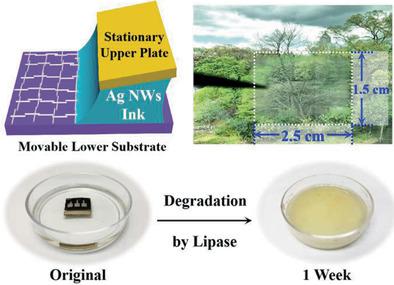当前位置:
X-MOL 学术
›
Adv. Energy Mater.
›
论文详情
Our official English website, www.x-mol.net, welcomes your
feedback! (Note: you will need to create a separate account there.)
Large‐Grained Perovskite Films Enabled by One‐Step Meniscus‐Assisted Solution Printing of Cross‐Aligned Conductive Nanowires for Biodegradable Flexible Solar Cells
Advanced Energy Materials ( IF 24.4 ) Pub Date : 2020-08-02 , DOI: 10.1002/aenm.202001185 Jiabin Qi 1, 2 , Shuo Chen 2 , Chuntao Lan 1, 2 , Aurelia Chi Wang 1 , Xun Cui 1 , Zhengwei You 2 , Qinghong Zhang 2 , Yaogang Li 2 , Zhong Lin Wang 1 , Hongzhi Wang 2 , Zhiqun Lin 1
Advanced Energy Materials ( IF 24.4 ) Pub Date : 2020-08-02 , DOI: 10.1002/aenm.202001185 Jiabin Qi 1, 2 , Shuo Chen 2 , Chuntao Lan 1, 2 , Aurelia Chi Wang 1 , Xun Cui 1 , Zhengwei You 2 , Qinghong Zhang 2 , Yaogang Li 2 , Zhong Lin Wang 1 , Hongzhi Wang 2 , Zhiqun Lin 1
Affiliation

|
Increasing performance demand associated with the short lifetime of consumer electronics has triggered fast growth in electronic waste, leading to serious ecological challenges worldwide. Herein, a robust strategy for judiciously constructing flexible perovskite solar cells (PSCs) that can be conveniently biodegraded is reported. The key to this strategy is to capitalize on meniscus‐assisted solution printing (MASP) as a facile means of yielding cross‐aligned silver nanowires in one‐step, which are subsequently impregnated in a biodegradable elastomeric polyester. Intriguingly, the as‐crafted hybrid biodegradable electrode greatly constrains the solvent evaporation of the perovskite precursor solution, thereby generating fewer nuclei and in turn resulting in the deposition of a large‐grained dense perovskite film that exhibits excellent optoelectronic properties with a power conversion efficiency of 17.51% in PSCs. More importantly, the hybrid biodegradable electrode‐based devices also manifest impressive robustness against mechanical deformation and can be thoroughly biodegraded after use. These results signify the great potential of MASP for controllably assembling aligned conductive nanomaterials for biodegradable electrodes. As such, it represents an important endeavor toward environmentally friendly, multifunctional and flexible electronic, optoelectronic, photonic, and sensory materials and devices.
中文翻译:

通过一步弯月形辅助溶液印刷交叉对准的导电纳米线实现可生物降解的柔性太阳能电池的大晶粒钙钛矿薄膜
与消费电子产品的短寿命相关的性能要求不断提高,引发了电子废物的快速增长,从而导致了全球范围内严重的生态挑战。本文中,报道了明智地构建可方便地生物降解的柔性钙钛矿太阳能电池(PSC)的稳健策略。该策略的关键是利用弯月辅助溶液印刷(MASP)作为一步一步生成交叉排列的银纳米线的简便方法,然后将其浸渍在可生物降解的弹性体聚酯中。有趣的是,制成的混合生物可降解电极极大地限制了钙钛矿前体溶液的溶剂蒸发,从而产生更少的原子核,进而沉积出大颗粒的致密钙钛矿薄膜,该薄膜具有出色的光电性能,在PSC中的功率转换效率为17.51%。更重要的是,基于生物可降解电极的混合设备在机械变形方面也表现出令人印象深刻的坚固性,使用后可以进行彻底的生物降解。这些结果表明,MASP在可控制地组装用于可生物降解电极的定向导电纳米材料方面具有巨大潜力。因此,它代表了对环保,多功能和灵活的电子,光电,光子和传感材料和装置的重要努力。基于电极的混合可生物降解设备还具有出色的抗机械变形能力,使用后可进行彻底生物降解。这些结果表明,MASP在可控制地组装用于可生物降解电极的定向导电纳米材料方面具有巨大潜力。因此,它代表了对环保,多功能和灵活的电子,光电,光子和传感材料和装置的重要努力。基于电极的混合可生物降解设备还具有出色的抗机械变形能力,使用后可进行彻底生物降解。这些结果表明,MASP在可控制地组装用于可生物降解电极的定向导电纳米材料方面具有巨大潜力。因此,它代表了对环保,多功能和灵活的电子,光电,光子和传感材料和装置的重要努力。
更新日期:2020-09-15
中文翻译:

通过一步弯月形辅助溶液印刷交叉对准的导电纳米线实现可生物降解的柔性太阳能电池的大晶粒钙钛矿薄膜
与消费电子产品的短寿命相关的性能要求不断提高,引发了电子废物的快速增长,从而导致了全球范围内严重的生态挑战。本文中,报道了明智地构建可方便地生物降解的柔性钙钛矿太阳能电池(PSC)的稳健策略。该策略的关键是利用弯月辅助溶液印刷(MASP)作为一步一步生成交叉排列的银纳米线的简便方法,然后将其浸渍在可生物降解的弹性体聚酯中。有趣的是,制成的混合生物可降解电极极大地限制了钙钛矿前体溶液的溶剂蒸发,从而产生更少的原子核,进而沉积出大颗粒的致密钙钛矿薄膜,该薄膜具有出色的光电性能,在PSC中的功率转换效率为17.51%。更重要的是,基于生物可降解电极的混合设备在机械变形方面也表现出令人印象深刻的坚固性,使用后可以进行彻底的生物降解。这些结果表明,MASP在可控制地组装用于可生物降解电极的定向导电纳米材料方面具有巨大潜力。因此,它代表了对环保,多功能和灵活的电子,光电,光子和传感材料和装置的重要努力。基于电极的混合可生物降解设备还具有出色的抗机械变形能力,使用后可进行彻底生物降解。这些结果表明,MASP在可控制地组装用于可生物降解电极的定向导电纳米材料方面具有巨大潜力。因此,它代表了对环保,多功能和灵活的电子,光电,光子和传感材料和装置的重要努力。基于电极的混合可生物降解设备还具有出色的抗机械变形能力,使用后可进行彻底生物降解。这些结果表明,MASP在可控制地组装用于可生物降解电极的定向导电纳米材料方面具有巨大潜力。因此,它代表了对环保,多功能和灵活的电子,光电,光子和传感材料和装置的重要努力。











































 京公网安备 11010802027423号
京公网安备 11010802027423号